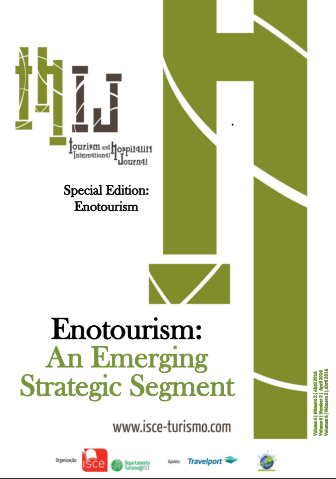O Google Trends como um indicador válido para as receitas da produção vinícola
DOI:
https://doi.org/10.57883/thij6(2)2016.30309Keywords:
wine tourism, google trands, wine incomeAbstract
In this paper we review the concept and importance of wine tourism in our country, considering that despite being an alternative tourism has increased significantly in recent years. It is also a sector, the wine, which has risen because it has improved the quality of the wine; culture has spread around it, and the fashion factor. Through a panel econometric model will demonstrate how google search for wine in the countries that produce them have explanatory power about the revenue from this sector.
References
Algina, J.; Swaminathan, H. (1977): A procedure for the analysis of time-series designs. Journal of Experimental Education, 4 (5), 56-60.
Algina, J.; Swaminathan, H. (1979): Alternatives to Simonton’s analyses of the interrupted and multiple-group time-series designs. Psychological Bulletin, 86, 919-926.
Andreu, R. Verdu, L. (2012): Turismo enológico en Alicante: La ruta del vino en el municipio de Pinoso. Cuadernos de Turismo, 30, 35-61. ISSN 1139-7861.
Askitas, N., & Zimmermann, F. (2009): Google econometrics and unemployment forecasting. Applied Economics Quarterly (formerly: Konjunkturpolitik), Duncker & Humblot, Berlin, 55 (2), 107–120.
Beames, G. (2003): “The Rock, the Reef and the grape: The challenges of developing wine tourism in regional Australia”. Journal of Vacation Marketing, 9 (3), 205-212.
Bono; R.; Arnau, J. (2000): Diseños de muestras pequeñas: análisis por mínimos cuadrados generalizados. Psicothema. 12, (2), 87-90.
Bruwer, J. (2003): “South African wine routes: some perspectives on the wine tourism industry´s structural dimensions and wine tourism product”. Tourism Management, 24 (4), 423-435.
Dodd, T. y Bigotte, V. (1997): “Perceptual Differences among visitors groups to wineries”. Journal of Travel Research,. 35,. 46-51.
Elías, L.V. (2006): El Turismo del vino: otra experiencia del ocio. Bilbao, Universidad de Deusto.
Getz, D. et al. (1999): “Critical Success Factors for Wine Tourism”. International Journal of Wine Marketing, 11(3), 20-43.
Getz, D. (2000): Explore Wine Tourism: Management, Development and Destinations, Cognizant CommunicationCorporation, New York.
Getz, D. y Brown, G. (2006): “Critical Success factors for wine tourism regions: a demand analysis”. Tourism Management, 27 (1), 146-158.
Gómez-Martínez, R. (2013): Señales de inversión basadas en un índice de aversión al riesgo. Investigaciones Europeas de Dirección y Economía de la Empresa, 19 (3), 147–157.
Gómez-Martínez, R., Prado-Román, M., & Mercado-Idoeta, C. (2015). Google search activity as entrepreneurship thermometer. In M. Peris-Ortiz & J.-M. Sahut (Eds.), New challenges in entrepreneurship and finance. Switzerland: Springer. 225–233.
Hall, C.M, Longo, A.M, Mitchel, R. and Johnson, G. (2000): ”Wine tourism in New Zealand,” Wine Tourism Around theWorld: Development, management and markets, C.M. Hall,L. Sharples, B. Cambourne and N. Macionis, eds., Butterworth-Heinemann, Oxford, 150-176.
Hall, C. M. y Mitchell, R. (2000): “Wine tourism in theMediterranean: a tool for restructuring and Development”.Thunderbird International Business Review, vol. 42 (4), 445-465.
Instituto Español de Comercio Exterior (2005): Notas sectoriales: “El enoturismo internacional” ICEX. Septiembre.
McLaren, N., & Shanbhoge, R. (2011): Using internet search data as economic indicators. Bank of England Quarterly Bulletin, Junio0 Última visita diciembre de 2014 http://www.bankofengland.co.uk/publications/quarterlybulletin/qb110206.pdf
Jaffe, E. y Pasternak, H. (2004): “Developing wine trails as a tourist attraction in Israel”. International Journal of Tourism. Research, 6 (4), 237-249.
Lockshin, L. y Spawton, T. (2001): “Using involvement and brand equity to develop a wine tourism strategy”.International Journal of Wine Marketing, 13 (1), 72-81.
RECEVIN (2006): Carta Europea del Enoturismo. Red Europea de Ciudades del Vino Disponible en:http://www.recevin.net/downloads/Charte_ES.pdf
O´Neill, M. y Palmer, A. (2004): “Wine Production andTourism,” Cornell Hotel and Restaurant AdministrationQuarterly, 45 (3), 269-284.
Rose, A. K., & Spiegel, M. M. (2012): Dollar illiquidity and central bank swap arrangements during the global financial crisis. Journal of International Economics, 88 (2), 326–340.
Simonton, D. K. (1977): Cross-sectional time-series experiments: Some suggested statistical analyses. Psychological Bulletin, 84, 489-502.
Smith, G. P. (2012): Google Internet search activity and volatility prediction in the market for foreign currency. Finance Research Letters, 9 (2), 103–110.
Swaminathan, H. y Algina, J. (1977): Analysis of quasi-experiments time-series designs. Multivariate Behavioral Research, 12, 111-131.
Szivas, E. (1999): “The development of wine tourism in Hungary”. International Journal of Wine Marketing, 11 (2), 7-17.
Vargas, A; Porras, N.; Plaza M; Riquel, F. (2008): Turismo enológico: comportamiento del turista y percepción de la población residente. Papers de Turismo, 97-111.
Velicer, W. F. y McDonald, R. P. (1984): Time series analysis without model identification. Multivariate Behavioral Research, 19, 33-47.
Velicer, W. F. y McDonald, R. P. (1991): Cross-sectional time series designs: A general transformation approach. Multivariate Behavioral Research, 26, 247-254.
VINTUR (2006): «Carta europea del enoturismo». Disponible en: http://www.recevin.net/ pdf/Charte_ES.pdf
Vlastakis, N., & Markellos, R. N. (2012). Information demand and stock market volatility. Journal of Banking & Finance, 36 (6), 1808–1821.
Wargenau, A. y Che, D. (2006): “Wine tourism development marketing strategies in Southwest Michigan”.International Journal of Wine Marketing, 18 (1), 45-60.
WESTERN AUSTRALIAN TOURISM COMMISSION (2000): Wine Tourism Strategy, Western Australia, Western Australian Tourism Commission/Wine Industry Associa-tion of Western Australia, Perth.
Williams, P. (2001): “Positioning wine tourism destinations: an image analysis”. International Journal of Wine.Marketing, 13 (3), 42-58.
Williams, P. W. y J. Kelly (2001): “Cultural wine tourists:product development considerations for British Columbia'sresident wine tourism market”. International Journal of Wine Marketing, 13 (3), 59-76.
Wooldridge, J. M. (2010): Econometric analysis of cross section and panel data. Cambridge, MA: Massachusetts Institute of Technology University Press.
Yuan, J. Cai, L.A; Morrison, A.M y Linton, S. (2005): “An analysis of wine festival attendes motivations: a synergy of wine, travel and special events?” Journal of vacation Marketing. 11 (1), 41-58.
Downloads
Published
How to Cite
Issue
Section
License
Copyright (c) 2016 This work is licensed under a Creative Commons - Attribution 4.0 International (CC BY 4.0)

This work is licensed under a Creative Commons Attribution 4.0 International License.
This work is published under the Creative Commons Attribution 4.0 International License.






